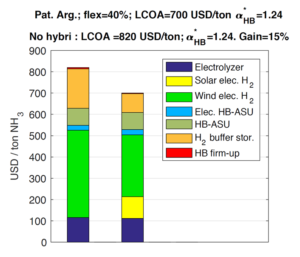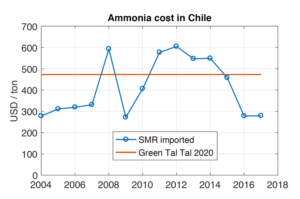Study Models NH3 Economics from Variable Energy Resources
By Stephen H. Crolius on May 28, 2019
Last week IEA Consultant Julien Armijo and IEA Senior Analyst Cédric Philibert submitted their study Flexible Production of Green Hydrogen and Ammonia from Variable Solar and Wind Energy: Case Study of Chile and Argentina to the International Journal of Hydrogen Energy and concurrently posted it on ResearchGate. The study addresses one of the key questions of the energy transition: what are the economics of producing hydrogen, or a hydrogen carrier such as ammonia, at sites with excellent renewable energy resources? The answer, framed in terms of the cost-competitiveness in local markets of green ammonia vs. conventionally produced brown ammonia, casts an encouraging light on the eventual prospects for international trade in green ammonia as an energy commodity.
The study opens with a statement that underscores the importance of the topic:
Green hydrogen production via water electrolysis is the paradigm of industrial conversion of renewable electricity into chemical energy, storable and transportable. As such, water electrolysis and more generally, power-to-X are attracting rapidly increasing attention, because of their promise of unleashing the potential of low-emission renewable energies (RE) way beyond electricity, and pave the way for realistic planning of a global economy with net zero emissions.
J. Armijo, C. Philibert, Flexible Production of Green Hydrogen and Ammonia from Variable Solar and Wind Energy: Case Study of Chile and Argentina, ResearchGate, May 2019.
Readers who have followed previous Ammonia Energy reporting on the IEA’s interest in this topic will recall that Chile and Argentina have global significance in this regard:
[Both] countries [have] world-class variable renewable energy (VRE) potentials. Northern Chile has the world’s strongest and most stable solar resource, and also good wind in the north, the south and excellent wind in the far south. Argentina has among the world’s best onshore wind potentials in its vast desert Patagonian steppes, and very good solar in the North . . .
Both countries thus appear as two possible champions, with tremendous potentials not only for domestic RE and H2 consumption, but also for becoming exporters of renewable energy stored in H-rich chemicals more convenient to transport, store and use, that is, not only diatomic H2 but also NH3 or carbon-based synthetic fuels.
J. Armijo, C. Philibert, Flexible Production of Green Hydrogen and Ammonia from Variable Solar and Wind Energy: Case Study of Chile and Argentina, ResearchGate, May 2019.
Global supply chains don’t just appear out of nowhere, of course; often they are built on local commercial arrangements. In this spirit, Armijo and Philibert survey the national energy markets in Chile and Argentina and the evolving opportunities for green commodities within them. Chile is actively engaged in the energy transition. Solar already accounts for 10% of installed electrical generating capacity and wind for another 6%. Further development continues apace, and is encouraged by a modest tax on CO2 emissions from the electricity sector. The national economic development authority is promoting hydrogen energy development. A Chilean manufacturer of explosives is investigating the possibility of domestic ammonia production based on renewable electricity. Last year the country hosted 400 attendees at the 2nd International Conference on Green Hydrogen.
Argentina is at an earlier stage of the transition, but last year saw a major acceleration in development of renewable generation, and in fact gained recognition as the world’s fastest growing market for wind power.

Armijo and Philibert’s study focused on two sites in each country, selected for the quality of their solar and wind resources. “Our goal,” the authors say, “is essentially to treat the situation of abundant and cheap renewable resources, in locations far from consumption centers where grids are generally weak, therefore, our modeling is based only on wind and solar resources, so that we face the questions of variability completely.” One of the study’s strengths is its high-resolution approach to the variability in wind and solar resources. Hourly data for an entire annual cycle was assembled for each site. This does justice both to daily patterns of sunshine and wind, to their seasonality, and to their variation at synoptic (meteorological) scale.
The authors then install a set of virtual production assets at each site, starting with both wind and solar farms, proceeding through hydrogen production via electrolysis, and culminating in ammonia production via conventional Haber Bosch synthesis. Hydrogen buffer storage, installed between the electrolyzers and the Haber Bosch plant, turns out to be a major wild-card cost factor. It is expensive relative to the system’s other capital elements, and the amount needed can vary widely depending on a location’s generating profile and system configuration.


The study examines a variety of important questions, including one that was instrumental in motivating the whole exercise: is there benefit in locating green ammonia production in places that are strong in both solar and wind resources? This is addressed through the modeling of production economics at one of the sites in each country. In Argentine Patagonia, the overlap or “hybridization” of solar and wind resources leads to a cost advantage of 15% vs. a non-hybridized approach. The key factor underlying this result is the amount of hydrogen buffer storage. Generation at this site is dominated by wind, which blows strongly but is highly variable. In a non-hybridized scenario, this variability must be buffered with stored hydrogen. Adding a relatively small amount of solar generation can “’regularize’ the wild wind resource” and reduce the needed hydrogen storage capacity.

For the Taltal site in Chile, the hybridization advantage is only 5%. Here the generation is dominated by solar. Adding a small amount of wind generation reduces the amount of “firm-up” electricity needed to sustain the ammonia production process at night. (“Firm-up” electricity is either produced locally using stored hydrogen or ammonia, or, when possible, sourced from the grid.) In this case, though, the hybridization advantage is limited by the relatively modest firm-up need in the solar-only scenario.
The study’s most important conclusions, arguably, relate to the commercial prospects for green ammonia in Chile and Argentina. In both countries, a promising picture emerges:
This work shows that, under realistic near term assumptions, in these locations that all boast world-class wind or solar, green H2 and NH3 could be soon produced at costs almost competitive with the traditional fossil fuel alternatives . . .
In both Chilean and Argentinian Patagonia, very promising opportunities could also emerge for producing green H2 or NH3 from wind, and perhaps some solar in the northernmost locations, possibly firmed-up by some stranded hydro resources that could also allow to buffer the variability and ease the operations. Due to the quality of the resource and the vast desert spaces, such cases could aim at large scale export of synthetic fuels via pipelines and ships . . .
NH3 production in northern Chile seems a particularly low hanging fruit, due to the existence in the area of a mature solar market, with an excellent resource, interesting wind options, available water desalination technology, . . . better present financial conditions, . . . and large local consumption due to mining, in particular for the direct use in explosives (as well as local consumption of oxygen).
J. Armijo, C. Philibert, Flexible Production of Green Hydrogen and Ammonia from Variable Solar and Wind Energy: Case Study of Chile and Argentina, ResearchGate, May 2019.